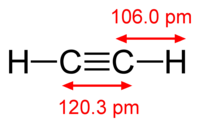
Photo from wikipedia
Abstract Methanation of carbon oxides is an important route to produce synthetic gas for civil use. Understanding acidic/basic properties of catalyst on the reaction intermediates in methanation provides important information… Click to show full abstract
Abstract Methanation of carbon oxides is an important route to produce synthetic gas for civil use. Understanding acidic/basic properties of catalyst on the reaction intermediates in methanation provides important information for developing highly active catalysts. In this study, the Ni/Al2O3, Ni/SiO2 and Ni/Hβ40 catalysts with varied distribution of acidic/basic sites were prepared and evaluated. The results indicated the importance of basic/acidic sites in determining the catalytic activities and the reaction intermediates formed. Ni/SiO2 and Ni/Hβ40 with medium to strong basic sites were far more active and selective than the Ni/Al2O3 in CO2 methanation. The in situ Diffuse Reflection Infrared Fourier Transform Spectroscopy (DRIFTS) study indicated that formate species, the important reaction intermediate for CH4 formation, was absent over Ni/Hβ40 and Ni/SiO2 while was accumulated over Ni/Al2O3, relating to presence of the positively charged Lewis acidic sites that had a strong affinity to the negatively charged formate species, deterring subsequent conversion of formate to CH4. In addition, the absorption of *CO over Ni/Hβ40 and Ni/SiO2 facilitated its activation and further conversion to methane, resulting in low CO selectivity and low tendency towards coking.
Journal Title: Fuel
Year Published: 2020
Link to full text (if available)
Share on Social Media: Sign Up to like & get
recommendations!